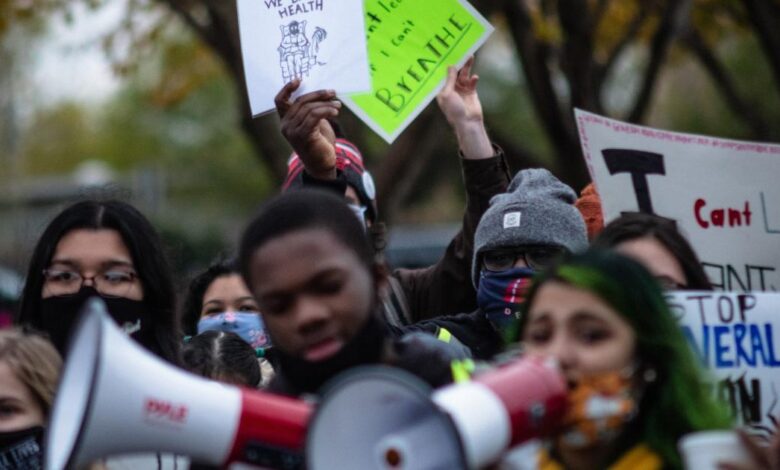It’s Been One Battle After Another

[ad_1]
Cheryl Johnson
A mother who began to ask questions
I grew up in Altgeld Gardens, a housing project on the far South Side that was originally built for Black World War II veterans. In 1969, my father died from lung cancer at the age of 41, and my mother, Hazel Johnson, started wondering why so many people in the area have died of cancer.
She started doing research. She learned that the South Side had the highest incidence of cancer than any other area in Chicago. She wanted to know why a lot of people had asthma and other health problems. She learned that our area had 50 documented landfills, hundreds of hazardous waste sites, and leaking underground storage tanks. And, all around us, we had industry that constantly emitted air pollution. My mom called our community “the toxic doughnut” because we were completely surrounded. In 1979, she founded People for Community Recovery to raise environmental awareness and help local people impacted by pollution.
“They tried to break her spirit”
In the early years, it was very difficult for my mother. She didn’t have a science background; she was not educated or trained in this area. She just knew that something was wrong.
Many times, I wanted to fight people for the way they treated my mother. Elected officials would say to her, “Well, the garbage has to go somewhere. Why not your neighborhood?” Or they would claim that the pollutant in the air was not as bad as what she said it was. They treated her so rudely. She would come home crying because someone called her a big-mouthed woman or an ignorant person or told her she didn’t know what she was talking about. They tried to break her spirit—that’s hard for a child to see. She would call our local Environmental Protection Agency Region 5 office, but they wouldn’t work with her because they had no jurisdiction over the impact that industry had on a community. They were only mandated to regulate industry and to work with academic institutions, but not with a community.
Early victory for safe water
One of our first environmental victories was right next to our community in Maryland Manor, a subdivision bordering Altgeld Gardens, in 1984. For 25 years, the residents there were paying taxes on a sewer line and water hookup that they never had. They had well water that was very contaminated with pollution.
The history of pollution there goes all the way back to the 1860s when [industrialist and inventor] George Pullman used to own the land and had a sewage farm in this area. It was used as a dumping ground for a long time. Testing of the well water showed cyanide and other contaminants. We were able to get the city to install water and sewer lines. It’s interesting that here we are today, over 100 years later, still here on this land, and we are still talking about environmental justice.
Recognition and a growing movement
In the early 1990s, my mother began to travel and meet with other community groups. She received President George Bush’s Environment and Conservation Challenge Award in 1992. Being with her at the White House when she received that award is an experience I’ll never forget. The previous year, the first National People of Color Environmental Leadership Summit took place. It was there that she was first called the “mother of the environmental justice movement.” [Delegates from around the county] all joined together [at the summit] and came up with the 17 Principles of Environmental Justice. That meeting helped lead to President Clinton’s signing of Executive Order 12898 in 1994, which said federal agencies had to consider environmental impacts on communities of color and low-income communities.
Resistance to environmental justice
My mother passed in 2011, and about a year after that, there started to be a little more awareness and recognition of the environmental justice groups in Chicago. For decades, the city has been wholeheartedly resistant to recognizing environmental justice, especially under the Daley administration. [Richard M. Daley was the mayor of Chicago from 1989 to 2011.] In fact, during that period, we learned that the Chicago Housing Authority [CHA] had dumped thousands of gallons of PCB waste right in the heart of my community. We had to fight with the city and CHA to clean it up—and to this day, I don’t think it was completed properly.
Current battles and planning for the future
This past year, we joined several local groups and filed a fair housing complaint with the Department of Housing and Urban Development. We are very concerned about the relocation of a recycling facility, General Iron, from Lincoln Park, a wealthier neighborhood, to our area. We talk about the city of Chicago just using our community as a dumping ground for so many years. Why do we always have to get polluting industries in our area? It’s not fair. Land-use practices in Chicago have been discriminatory.
My mother used to say that we know how to dirty up this country, but we don’t have the workforce to clean it up. One of the major goals of People for Community Recovery is to create training facilities in the area.
We were the first in the country to bring lead abatement training for workers to the community. We trained nearly 300 residents, and a little more than 80 percent of the folks would get jobs with contractors doing lead abatement. We are also working to promote our community to become a solar community and to have more education about energy efficiency. We are looking at how we can be engaged in the clean energy economy and get residents trained in those opportunities. This is the only place I’ve ever lived. It’s a good community if only the city and the state would invest instead of letting it go.
[ad_2]
Read More



